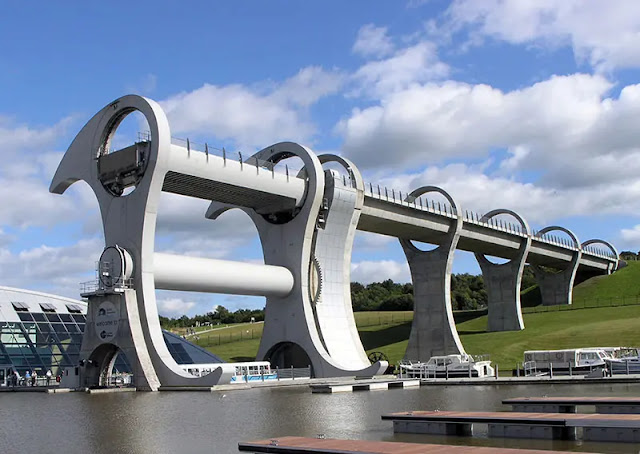Tunnel: (Satellite)
Locks: (Satellite)
 |
| Street View, Apr 2021 |
 |
| For the love of Narrowboats posted Falkirk wheel....79ft [24m] lift/fall in one go. Only rotating boat lift of its kind in the world, and one of two working boat lifts in the UK. [Over 2000 comments!] |
 |
| Charlie Pate commented on the above post Was there a couple of weeks ago, loved it and definitely a place to visit. |
 |
| traveling-savage "Standing almost exactly in the center of the triangle formed by Edinburgh, Glasgow, and Stirling, the Falkirk Wheel is more than just a structural curiosity. The Falkirk Wheel is the culmination of a project to reconnect Glasgow and Edinburgh by waterway, and it joins the Forth and Clyde Canal with the Union Canal by replacing the previous system of 11 locks that were dismantled in the 1930s." The wheel "was designed to look like a double-headed Celtic axe." We can see the gears that are used to keep the gondola level. |
 |
| BritishHeritage "As Scotland’s industrial output expanded following the Industrial Revolution, the traditional way of moving goods around cheaply and quickly was by canal. By the 1830s some 200,000 passengers and 3.3 million tons of goods were carried on canals annually....With the advent of the railways, canals fell out of use and the locks were eventually dismantled in 1933. As the 20th century drew to a close, however, they began to be used again for purely recreational purposes. British Waterways, the company responsible for the canals, decided that the Millennium should be marked by an iconic project that would be a memorial fit for the occasion. The outcome was the Millennium Link, an ambitious project to restore the canal system and reconnect Scotland’s two largest cities at a cost of around $135 million.The Wheel, costing $28 million, is the Link’s central feature." |
 |
| BritishHeritage You can take a 50-minute ride on the Archimedes up the lift and through the Roughcastle Tunnel and return. "The canal ride also offers glimpses of the remains of the Antonine Wall, once the most northerly frontier of the Roman Empire, built on the orders of the Emperor Antoninus in AD 142. Parts of it were later incorporated into the Forth & Clyde Canal during the 17th century, but now the remains are preserved wherever possible. In practical terms, the four-yard-high earth wall, deep ditch and regular fortifications built along its length proved no barrier to the marauding Picts. Consequently, it was abandoned after just two decades." The tunnel was built to minimize the impact on the Antonine Wall. |
 |
| lindahall, image credited to mjm.com "Primary credit for the final design is usually given to architect Tony Kettle of the architectural firm RMJM. It is often said that Kettle made his initial model of the gearing with pieces from his 8-year-old daughter's Lego set. Whenever you see a minor detail like "8-year-old daughter" repeated over and over in different articles, that is usually a good sign that the story is undocumented, and probably contrived, but who knows, maybe it is true. It is documented that when Kettle gave a tour of the wheel to Scottish school-kids in 2015, he gave each of them a bag of Lego pieces to build a model of the Wheel’s mechanism. I read once that his original Lego model was exhibited at the Victoria and Albert Museum in 2012, but I cannot find any corroboration of that or an image of the original model on exhibit. Wikipedia has a photo of a Lego model built by someone else ten years after, but that is not quite the same thing. It would be nice if Kettle would verify or deny the story himself; if that has occurred, it doesn’t seem to have made it to the internet." |
.jpg) |
| Highway Engineering Discoveries posted The Falkirk Wheel is a rotating boat lift in Tamfourhill, Falkirk, in central Scotland, connecting the Forth and Clyde Canal with the Union Canal. |
"The wheel was constructed and fully assembled at the Butterley Engineering plant in Derbyshire. It was then dismantled and driven to Falkirk in 35 lorry loads. Workers reassembled it into 5 sections which were lifted into place. As the wheel rotates in alternate directions, the changing load can cause stress to parts of the structure. To avoid fatigue – weakening caused by repeatedly applied loads – engineers bolted sections together instead of welding them." Each gondola holds the equivalent of an Olympic swimming pool. [ice]
I passed on two videos that started with talking head(s) and found this one. The intro ends at 0:52. This video is done talking about this lift at 7:36. The remainder of the video is about other canals.
 |
| 16:04 video @ 1:27 |
%20Facebook.png) |
| Facebook reel and 0:30 video |
 |
| 15:14 video @ 2:28 The Hidden Engineering Behind the Falkirk Wheel |
 |
| @ 3:18 |
No comments:
Post a Comment